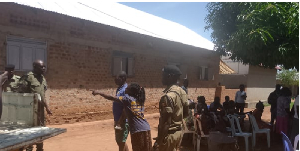- Home - Sports
- Soccer Portal
- Archived Sports News
- Sports Videos | TV
- Year In Review
- Sports Photos
- Sports Headlines
- Boxing
- Athletics
- Basketball
- Bodybuilding
- Cricket
- Golf
- Handball
- Hockey
- Martial Arts
- Tennis
- Volleyball
- Other Sports

Sports News of Saturday, 2 June 2001
Source: GNA
Most of the fans died from suffocation
 Colonel Justwant Mantey Wadhwani, the pathologist at the 37 Military Hospital has confirmed that, most of the fans died as a result of suffocation which came about as result of pressure on the chest entangled in a crowd, when he conducted post mortem on them.
Colonel Justwant Mantey Wadhwani, the pathologist at the 37 Military Hospital has confirmed that, most of the fans died as a result of suffocation which came about as result of pressure on the chest entangled in a crowd, when he conducted post mortem on them.
Giving the breakdown at his appearance at the Commission, Col. Wadhwani said, out of the 106 bodies, 97 died from suffocation, five died from chest injuries, four from head injuries while one person died from spinal injury.
He said if there had been a resuscitation exercise, most of them would have been alive by now.
Col. Wadhwani said the staff strength is low at the Hospital because there is one Cuban doctor assisting at the moment, a medical scientist and mortuary assistant.
He said the morgue could only take 60 bodies but could be raised in three folds to take 180 in emergency cases and that bodies could be kept there for only 48 hours.
Asked whether he was satisfied with the present conditions, Col. Wadhwani said he was satisfied with regards to the normal duties at the hospital.
Earlier on, Colonel Dr. Joseph Mensah Ayettey, the Commanding Officer of the Military Hospital appeared at the Commission to brief them about facilities at the hospital and how they are equipped.
Led in evidence by Defence Counsel, Mr Miguel Ribeiro, Col. Ayettey told the commission that, they have adequate facilities to cater for patients even though he said they are under staffed.
He said the hospital, which was initially established for military personnel now cater for civilians as well and the ward which is supposed to take 30 nurses has nine.
Asked by Professor Agyeman Badu Akosah, whether they have disaster management plan in case of any eventuality, Col. Ayettey said they have it on paper since 1983.
When Mr Sam Okudzeto asked him about the state of dialogue between the hospital and the other hospital and other agencies involved in disaster management, he said when periodic exercises are carried out they involve all the agencies.
Mr Okudzeto later told him that, there should be a co-ordinated communication between the hospital and the other health institutions to make their work easier.
Dr Augustus Engmann, a sports medical practitioner at the Stadium clinic was next to appear at the commission.
He told the Commission that he was not on duty that day and they were not invited to match.
He said the hospital operates independently from the NSC and has very little basic facilities.
He told the commission that the clinic that has a recovery ward, which could take four people at a time for physiotherapy has nothing more.
Dr Engmann also said it has two doctors including himself, four nurses and a physiotherapist.
He said during the renovation of the stadium, he suggested to the NSC to include the clinic and presented a document but it was not accepted rather they told him to use one of the rooms at the stadium for a first aid room which was was later used as a dressing room.
He said the First Aid room only has a couch, a desk and a blood pressure apparatus.
Dr Kofi Oteng Adu Darko, Acting Director of the Trust Hospital also appeared at the Commission and said he had only 10 minor cases and one dead person.
He said the injured were treated and discharged. Mr Mark Niezer Quaw, an audit assistant with the Quality Control Board was the next to appear to give an eyewitness account and said, the main gates that always lead to the stands are always locked they have to use two narrow gates to enter into the stands and do the same when matches end.










